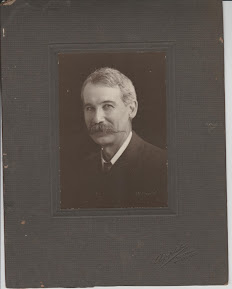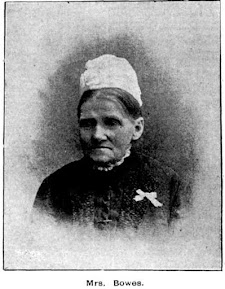A Man of Many talents who believed in Education
I intended for this week's
blog to be dedicated to those lesser-known architects calling Rookwood
"home" who have left an indelible mark on Sydney's landscape. As I
was compiling information, one person, who I must admit I had never heard of,
impressed me greatly with his ability to take on challenges in many other
fields and get the job completed. I felt he needed to have a piece written
solely about him and his achievements. A man who never let the grass grow under
his feet!
If I haven't heard of him, I
expect many of you haven't either so this blog is dedicated to a champion of
many things. I introduce.....
JAMES NANGLE - Architect,
Educator, Astronomer.
James was born in Newtown on the 28 December 1868 to Thomas Nangle and his wife Maria (nee Carney) and was their
eldest child. James commenced his working life at the age of 9, albeit
part-time, but by the age of 11 he was working in an engineering company. By 15
he was a carpenter's apprentice to a Newtown builder. He completed his time and
became a fully-fledged carpenter, then a Clerk of Works and draughtsman. During
the 1880's he attended classes at the Sydney Technical College and the
University of Sydney.
In 1891 James began practice
as an architect and in December 1892 married Helen Van Heythuysen. He became an
associate of the Institute of Architects of NSW in 1896 and honorary treasurer
the following year and later its secretary.
James Nangle - Ancestry.com - public access
James Nangle's architectural
work was residential, commercial and institutional. Two of his best-known
buildings were the stores erected for Marcus Clark at Newtown and the one on the corner
of Pitt and George Streets near Central Station (now part of the TAFE complex).
The building displayed influences from the Flat Iron Building in New York but
extensions later on removed any reference to it. He carried out a few
commissions for the Catholic Church including the Sacred Heart Church in
Darlinghurst. James also designed portable classrooms for the Department of
Public Instruction and the new architectural and building block at Sydney
Technical College at Ultimo and many others.
Marcus Clark Building near Central Station @ 1910 - showing the Flat Iron Building influence - Dictionary of Sydney
Marcus Clark Building with extensions made after 1928 - City of Sydney Archives
Sacred Heart Church Darlinghurst - Dictionary of Sydney
Just before his marriage
James begun teaching mechanical drawing for the technical education branch of
the Department of Public Institution. He offered to advertise the classes and
seek out students. By 1894 he was conducting two weekly classes and delivering
public lectures. In 1897 he was responsible for all drawing instruction at
Newtown. The following year he was transferred to the Sydney Technical
Collection where in 1905 James became lecturer in charge of the Department of
Architecture. In this role he restructured classes and redefined courses. The
Institute of Architects recognised his courses as part of the qualifications
necessary for membership.
Sydney Technical College - Dictionary of Sydney
Besides this James had
developed an interest in materials testing and his book on building practice
was deemed a necessary textbook. He wrote many papers and articles and was an
early supporter of the use of concrete and steel in buildings.
In 1913 James was appointed
superintendent of technical education and immediately became involved in
reforms to upgrade the state and content of training at technical colleges. New
trade and diploma courses were introduced. He suggested the
establishment of course advisory committees involving union and industry
representatives. Unfortunately, these reforms were not the success James had
hoped they would be. Insufficient funding led to accommodation problems despite
extra land allocation and the development of the East Sydney Technical College
during the 1920's. The word "vocation" reduced the range of technical
education, and many courses were lost to enable others to be extended. James, however,
managed to redefine the applied art courses at East Sydney and establish the
College's "National Art School" with its (still) highly regarded
courses from the ashes of the old Gaol buildings.
Conversion of the E Wing East Sydney Technical College @ 1921 - NAS Archives
In 1919 James accepted the
position of Director of Vocational Training under the Commonwealth Department
of Repatriation. His skill with course committees was considered necessary to
the essential acceptance of large numbers of partly trained men into the
workforce and he oversaw the training of 20,000 ex-servicemen in trade and
other courses operated by State Education Departments and other institutions.
James Nangle received an OBE
in 1920 for his efforts.
In 1927 James advised on the
establishment of a technical education system for Western Australia and chaired
an unemployment research committee set up by the State Government at the time.
James Nangle retired in 1933.
Although no longer working in the field of technical education, he became more
involved in his love of astronomy; he had designed a small observatory at his
Marrickville home, built and operated telescopes and written several papers on
his observations from 1910. He was the President of the local branch of the
British Astronomical Association many times and in the 1920's helped to replan
the observatory building and residence, where he moved his family to when he
was appointed Honorary Government Astronomer in 1926. Under his direction the
six-pip time-signal was introduced.
Sydney Observatory (before Nagle's replanning) @ 1976 - Dictionary of Sydney
Drawing of Venus by James Nangle 1931 - Powerhouse Museum Collection - with thanks
James Nangle served on Town
Planning committees, was a member and President of the Royal Society of NSW,
President of the Royal Australian Institute of Architects in 1936-1937, a
fellow of the Royal Institute of British Architects, He supported the establishment
of chairs of architecture and mechanical engineering and courses in domestic
science.
James Nangle (middle) with others later in life - Dictionary of Sydney
His final years were marred
by ill health, but he continued to run a small private correspondence
school, the Nangle Institute of Technology, which was operated by his family
until the 1960's.
James Nangle died of heart
disease on 22 February 1941 at the Observatory and was buried with
Congregational forms in the Independant area of Rookwood Cemetery – a life well
lived. He was survived by three sons and a daughter. His son Allan was a
renowned architect. He designed many buildings in the Sydney region and beyond; the War Memorial Chapel at Trinity Grammer Newington was his design. Another of
James' sons, Edwin, was also an architect and a grandson, James Alan Nangle, is
a retired architect.
James Nangle's simple headstone - Find-a-grave - with thanks.
As I was researching James
Nangle's achievements, I silently thanked him for his work in setting up
Technical College education, as I was one of the many hundreds of thousands of
students who undertook courses. I even participated in a course at the National
Art School not knowing I had this man to thank for setting it up. Thank you, Mr. Nangle!
James was a man with many,
many interests and obviously believed that education was the key to success. He
was a man well-liked and respected by his peers and was able to deliver his
projects because of the goodwill of his colleagues.
Once more it just goes to show
that the humblest of headstones can belie the greatness of the people who lie
below it.
I like to believe that if
James Nangle was perhaps forgotten, he is no more!
I have derived information
for this blog today via searches on ancestry.com, Google and various Trove
newspapers as well as the Dictionary of Sydney.
If you have any comments regarding this blog, please add them here or at the Group Facebook page which can be found under a search via
rookwoodcemeterydiscoveries
or send me a message via
lorainepunch@gmail.com
Until next week













Comments
Post a Comment